After I published this article about why we unschool our kids, I got quite a few requests for more detail. What does unschooling look like in practice? What do unschoolers do each day? The stock answer is that unschooling looks different for each family and different each day. Unschooling is more of an overarching philosophy than a day-to-day how-to guide about how to live and learn. With that caveat, I’m going to present a snapshot of what unschooling looked like in our family during what would have been my oldest daughter’s kindergarten year when she was five years old. My younger daughter, then three, was also along for the ride.

The first thing you need as a two-career family opting out of school is some kind of child care. If you already have a stay-at-home parent in the family, then you’ve got this covered. In our family, my husband has a fairly traditional nine-to-five job, whereas I have a somewhat more flexible but still full-time position. I am usually at work three full days per week, and fit in the rest in the evenings after the kids are asleep, on weekends, or sometimes in small bursts alongside my kids when they are doing their own projects.
Because our children were not in school, we hosted an au pair to handle our child care needs. I’ve previously written in depth about how the au pair program works, but in a nutshell an au pair is sort of like a blend between a foreign exchange student and a live-in nanny. Au pairs come from abroad and provide live-in child care for up to 45 hours per week, which you can schedule flexibly on a week-to-week basis.

Our approach
As unschoolers, we were not concerned with whether our kids met any specific grade-level standards, especially not at such a young age. This view is partly informed in part by my own early years. I was born in Finland and spent nearly half of my childhood there. The Finnish education system has been the subject of much interest during the past decade or so due to the strong performance of Finnish students on the international PISA test even though (or perhaps because) students do not start school until age 7, plenty of time is devoted to recess, there is generally no homework until well into the teenage years, and there is no standardized testing except for one exam at age 16. Knowing this, I was not enthusiastic about sending my children into a testing-heavy, recess-deprived environment at age 5, nor did I see any reason to evaluate their academic abilities at home. We had other priorities.
What we did
We made sure our kids had plenty of time for free play with other kids and a lot of outdoor time. I am convinced that these are activities we humans are wired to crave no matter where we live. We spent most of our existence as a species living almost entirely outdoors, and we still do better when we regularly experience fresh air, sunshine, and flowing water. We are also a social species. We crave time with other people and become agitated when we are too isolated. Like other intelligent animals, the youngest members of our species are born with a need and desire to play. As Jean Piaget famously said, “play is the work of childhood.” It is how kids learn physical skills, solve problems, build resilience, exercise creativity, and much more. The decline of play has even been linked by some psychologists to increasing levels of anxiety and depression. Somehow this necessary and vital activity is almost completely overlooked by public schools.

Our other priorities were having fun together as a family and reading books together. These are activities that are not universally required for human wellbeing, but that I believe help kids thrive in our society. Having fun together as a family strengthens bonds and makes you as a parent more influential in your kids’ lives. Reading together is also something all experts agree is beneficial for children. Early childhood education guidelines change regularly, but reading books together never goes out of style. That doesn’t mean that you have to rigidly schedule in reading time or try to force a busy toddler to sit down and listen to a book. It simply means taking the time to make storytelling and literacy a part of your family life. In our society, kids who have strong attachments with their parents and are read to regularly are kids who are thriving and learning.
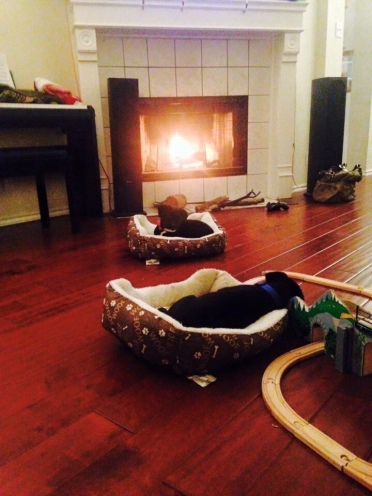
What we didn’t do
We didn’t create lesson plans. We didn’t buy a curriculum. We didn’t buy “educational” toys or materials. We didn’t buy much of anything at all, really. We didn’t try to “sneak in” learning activities into everyday experiences. We answered questions as they came up but didn’t lecture or try to turn every experience into a “learning opportunity.” I find that kids see through your ulterior motives pretty quickly, and nothing sucks the joy out of a fun time faster than someone going didactic on you when you’re just trying to explore.

So what did daily life look like?
Our weekly schedule looked like this.
Mondays and Wednesdays. Our kids had a full day with our au pair while we parents were both at work. Since we were already funneling money into child care, they mostly did free activities together. They spent a lot of time at the library and at local parks and playgrounds. They took part in Free Forest School, a national program that gets kids and parents outdoors to hike and explore nature. We had a membership to the local children’s museum, so that was a popular destination too. Our au pair also frequently organized play dates with other au pairs and their host kids.

Tuesdays. This was our weekly co-op day. A few members of our local unschooling group started the group as a way to build community and form friendships between unschooling kids and families. A frequent concern about homeschooling and unschooling from people outside of the community is the old refrain, “what about socialization?” As most homeschoolers and unschoolers can attest to, finding other kids to be around is easy. They are everywhere – at playgrounds, scout troops, piano lessons, etc. There is virtually no risk that your kids won’t have a chance to play with other kids. However, in my experience, as kids get older they don’t just want to be around any other kids – they want to see their friends. Finding a way to consistently see the same group of friends on a regular basis, ideally several times per week, can be more of a challenge. Co-ops are a great way to see the same peers regularly and build lasting friendships.
Thursdays. Park day. For a couple of years, the local unschooling group we are in organized a weekly park day at a centrally located park in town. The first families would usually show up around 11am (unschoolers usually like to sleep in) and some families would stick around until 4 or 5pm, with most people coming and going loosely within that window, bringing lunch, catching up with friends, and letting the kids play. This was one of the events our au pair normally took the kids to, but when I could go it was always one of my favorite things to do with the kids. In this isolating era of modern parenthood, relatively few experiences I’ve had with my kids that gave me a feeling of community, but this was one.
Fridays. A friend of ours invited us to try out a dance class at a local studio that had a class for 3-5 year olds. It was a three-hour program that consisted of one hour of ballet and tap dance followed by two hours of visual art, making instruments, acting out books, and dramatic play. My kids were hooked immediately, so we signed up. My youngest who was not quite 3 at the beginning of the year and had never spent any time away from me, my husband, or au pair, started with just the one-hour class. After she was done we would go to a playground together while we waited for big sister to finish the last two hours. It was a nice chance to spend some rare one-on-one time with my youngest.
As you can see, our routine left a lot of free time available. Even on our days with scheduled activities, we were gone for a maximum of about five hours. That’s a lot less than the 7-8 hours away a typical day of public school requires. I find that everyone in our family is happiest if we get up and go in the mornings: spend time outside, see friends, or do something stimulating. If we don’t do that, we all get a little irritable after a while. But after we’ve spent some time away, we’re all pretty happy puttering around at home and doing our own projects. Plenty of other families have different rhythms, but most unschoolers seem to understand the importance of downtime. No human being is supposed to be productive all the time.
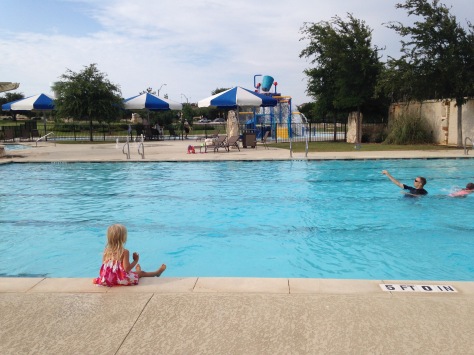
Did they learn what they needed to know?
As fans of the philosophy of unschooling, we did not have much interest in grade-level standards. Kids learn at their own pace and getting caught up in measuring and tracking their progress can really steal the joy kids experience form learning. Nevertheless, as we wrapped up the year and headed into summer, I got curious about what my daughter might have been doing if she had been in school that year. So, I looked up the kindergarten standards in our state to see what the kindergarten classrooms were up to. With school so often pushing reading at an early age and having kids clocking lots of time sitting at a desk (both of which we spent approximately zero time doing), I thought my daughter might be a bit behind most kindergarteners on a filling-out-worksheets kind of level. But I found out that wasn’t the case at all.
The curriculum guidelines for our state are broken up into ten different areas: English, Language Arts, & Reading; Mathematics; Science; Social Studies; Health Education; Physical Education; Art; Music; Theatre; Technology. The kindergarten standards I looked into are 30-page pdf document, so I won’t cover every point listed there in this article, but I’ve selected what I believe is a representative overview of the skills our public schools teach and grouped them into three categories.
1. Stuff your kids probably already know.
Although we have opted out of public school for our kids thus far, I am by no means opposed to public schools. In fact, I think it’s wonderful and necessary for a well-functioning society to have a system that provides an education to every child, regardless of what is or isn’t happening in the child’s home. However, this setup also means that public schools cannot assume that your child has received any kind of education at home. They cannot assume that your child has seen a book before, knows how to hold it, or knows that words that appear in print represent words you can speak, and so on. Those three examples are each taken directly from the state’s kindergarten curriculum for English, Language Arts, and Reading. This type of knowledge all has to be taught more or less systematically in schools, and it’s one of the reasons homeschooling can be accomplished in much less time than public schooling.
Other examples that fall into this category include knowing how to:
- Collect, sort, and organize data into two or three categories (Mathematics)
- Observe, describe, compare, and sort rocks by shape, size, color, and texture (Science)
- Observe and describe weather changes from day to day and over seasons (Science)
- Identify safe and unsafe places to play such as a backyard and street (Health Education)
- Identify selected body parts such as head, back, chest, waist, hips, arms, elbows, wrists, hands, fingers, legs, knees, ankles, feet, and toes (Physical Education)
- Sing songs and play musical games, including rhymes, folk music, and seasonal music (Music)
These are all things that come up in the course of everyday life together. We didn’t need a lesson plan to teach our kids that the backyard is a safe place to play but the street is not. That’s something they’ve naturally learned since toddlerhood, if not earlier. We didn’t need to set aside time to describe weather changes over seasons. That’s something we observe as we spend time outdoors. I didn’t need to bring rocks into a home classroom and set up sorting activity. Collecting and sorting rocks is a regular pastime. These activities are part of the regular play of children in nature if we only give them the opportunity and get out of the way.
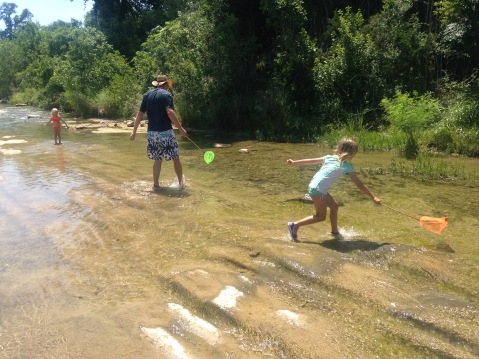
2. Stuff your kids might not know yet, but will easily learn later.
Because public school aims to ensure that no kid falls through the cracks without knowing basic information for getting through life, they spend instructional time on things that kids growing up with involved and caring parents will learn anyway. Maybe not this year, but soon enough. In our case, the following was a list of things we didn’t happen to spend time on during my daughter’s kindergarten year, but that I have zero concerns about her learning in due time. For example:
- Identify three-dimensional solids, including cylinders, cones, spheres, and cubes in the real world (Mathematics)
Does my daughter know what a cylinder is? I’m not sure. Am I worried about it? No. I’m sure she’ll pick up this particular piece of vocabulary soon enough if she hasn’t already.
- Use a picture dictionary to find words (English, Reading, and Language Arts)
We don’t have a picture dictionary, but we demonstrate looking up information on a regular basis. Usually we are googling information about a topic like space or animals or photosynthesis. I have absolutely no concerns that my kids might go through life without knowing how to look up words or other information they want to know.
- Use knowledge of letter-sound relationships to decode regular words in text and independent of content (e.g., VC, CVC, CCVC, and CVCC words) (English, Reading, and Language Arts)
This refers to learning how to read simple words composed of one vowel and one consonant, two consonants with a vowel between them, etc. If your goal is to get 30 young children to read as quickly as possible, perhaps this approach has some merit. If not, I think it complicates reading more than it simplifies it. We were not concerned about our daughter being able to read by the end of her kindergarten year, so we didn’t bother with this type of thing. Now at nearly 7, she has recently taken off as a fluent reader and is delving into chapter books – no VC/CVC/CCVC lessons required.
3. Stuff you can probably do better on your own.
There are also a number of items that I know we can do a better job of teaching or providing for our kids. I’ve listed a few examples below.
- Identify contributions of historical figures, including Stephen F. Austin, George Washington, Christopher Columbus, and José Antonio Navarro, who helped to shape the state and nation (Social Studies)
Knowing about historical figures is important, but the list above fails to inspire me. I’m sad to see that in 2018, there are no women included in this list and that it’s very white on top of that. I realize the above is not a complete list, and I’m sure there are many wonderful teachers who go out of their way to make sure every child sees their own culture and history represented in the historical figures presented in their classrooms. Nevertheless, schools are famous for teaching history with a focus on white men, and this list doesn’t do anything to debunk that reputation. I want a better education than that for my daughters.
- Name the harmful effects of tobacco, alcohol, and other drugs
I’ve long been flummoxed by the anti-drug education that starts so young in schools. I’ve seen pictures from our local elementary school in which the door to the kindergarten room proudly proclaims that the students are “drug free.” Huh? Given that there no epidemic of drug-addicted 5 year olds, this doesn’t seem to be a feat worth announcing. Research shows that addiction appears to be the result of a combination of factors including experiencing childhood trauma, isolation, lack of opportunity, and genetic predisposition. Touting your drug-free status as a personal achievement (and by implication shaming those who fail to achieve it) is a misleading way to address a complex social problem like addiction.
- Use voting as a method for group decision making
Our kids have come with us to vote many times. I remember the first time we brought our daughter to vote when she was old enough to understand a little bit of what was happening. After filling out our ballots and getting our “I voted” stickers, she remarked, “That was fun! Can we do it again?!” That sparked a great discussion about representation and everyone having an equal say, at least in theory. Unschooling and homeschooling provide amazing opportunities to participate in democracy and see the government at work, whether it’s going to vote, volunteering for a local campaign, writing letters and making calls to your representatives, or as kids grow older, going to observe local courtroom proceedings, or watching the legislature in session if you live in or near a state capital.
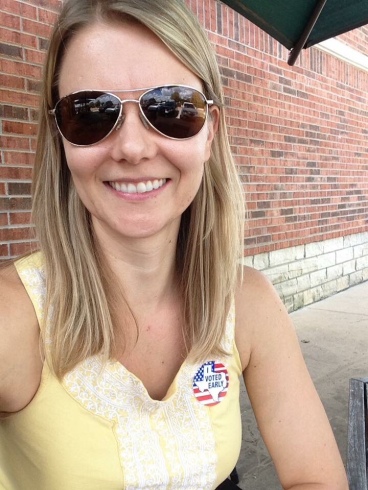
- Participate in moderate to vigorous physical activities on a daily basis that cause increased heart rate, breathing rate, and perspiration (Physical education)
This is an important goal, but also one that we can accomplish much better ourselves. Children are supposed to engage in at least 60 minutes of vigorous physical activity each day. I think children in public schools will generally be hard pressed to achieve this goal because among schools that provide recess, the average length is only 27 minutes per day. Once you factor in time to line up and cancelled recess due to cold or rainy weather days (which don’t deter our family from getting outside), the actual time spent in vigorous play is probably much less.
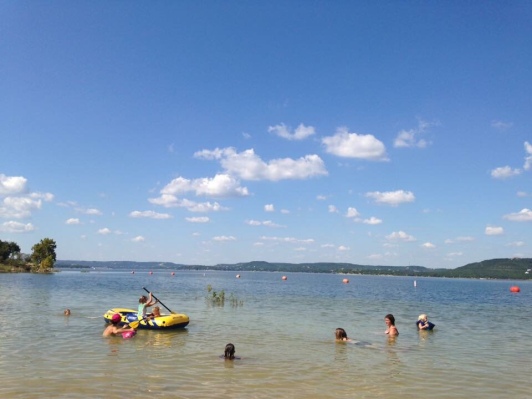
Who are the best candidates for unschooling and homeschooling?
I think just about any child can benefit from a relaxed, home-based education. The question is whether it works for the parents. Unschooling and homeschooling require much more extensive parental involvement in your child’s life than public schooling, and not every family has the opportunity or desire to play this kind of role in their child’s life. However, if the opportunity and desire are there, you already have the two things you need most to provide an excellent education.


I love this post!
My son is 3 now so I’ve begun thinking about where and when he’ll be going to school.
And the public schools in my city are terrible, many of the local schools are actually, so I’m not keen on sending him there.
So this is super helpful! I definitely have the desire to do homeschooling in some form, but didn’t know where to begin, until now at least!
Now I’m definitely curious to see what my states kindergarten guidelines are!
Great post!
LikeLike
Thank you! I really think it’s less complicated than it first seems, at least in the early years. (Maybe the later years too, but we haven’t gotten there yet.) If you are in charge of managing and educating 30 kids, that requires a lot of planning and coordination. Making sure just your child is thriving is something you’ve already been doing since their birth. 🙂
LikeLike
Your days are very similar to ours. It’s nice to hear from another family whose parents both work yet still unschool. The three kids here 7, 5, and 3 are picking up what they really need to know as they go. One of my favorite aspects of our experience is that the kids are integrated with the community here, building a city-wide network for themselves just because they have the time to get out and interact with people every day.
LikeLike
Yes, I love how unschooling and homeschooling give kids so much opportunity to interact with the community at large. When I was in high school I remember going downtown to the local university one school day because I was taking an AP test. I had this realization that there was a whole world out there I had been missing out on for years. Hopefully my kids will feel more like part of the community and the world.
LikeLiked by 1 person
Thanks for writing this! This is very timely for us because our 5 year old is going to start Sudbury schooling soon. Also, we are going to host our very first au pair soon and we live in Austin. It’s so true that learning happens all the time with no instruction. In fact after spending a few years at a wonderfully alternate pre school, our daughter seems to already know what’s expected by the school district at the end of the kindergarten year – all with zero instruction and with a lot of freedom to just explore. Here’s hoping that our ‘kindergarten’ year goes by with equal excitement and life learning. I’d love to check in here and follow your unschooling adventure.
LikeLike
Oh wow, we have a lot in common! I’ve heard great things about the Sudbury school here, so hopefully you have a fantastic year there. I plan to keep posting about each year as as time goes by, so please do check in again. I’ll write about our first grade year pretty soon here! We ended up doing a few days a week at an alternative school, which has been a great hybrid option for now. Just taking each year one at a time!
LikeLike
Great post! I don’t know how you fit everything in, even with the au-pair but it looks like you’re doing an amazing job of it, and what a fantastic thing to do for your children. I’ve schooled both my boys so far but if that ever stops working for them I’d definitely consider un-schooling. This is a lovely article, very informative too, thank you.
LikeLike
Thank you so much! It can be a juggling act at times, but I think that’s true for any family with young kids.
If school is working for any given family, that’s fantastic. Overall I enjoyed most of my public school experience. My hope is that those families and kids school does not work for will know that there is another viable option that doesn’t require extremely specialized expertise of a ton of money.
LikeLiked by 1 person
homeschooling my toddler now because I know that at her age she can still be clingy and night not want be left alone at a playschool.She enjoys whenever I read her books aloud with matching acting and very happy when we play together.I believe that you are soing a great job raising your children and would love to so sone of your activities as well in time.
LikeLike
A belated thank you for your comment! If you’re on Instagram, feel free to follow along for snapshots of our daily lives and activities there.
LikeLike
Great post. So many benefits to homeschooling/unschooling. I had an au pair as a child and think it is fair to say you need to make sure that they align with your family values. If you get this right, it can be a great experience. A detailed and informative post – thank you for sharing.
LikeLiked by 1 person
Thank you! Yes, finding an au pair whose values match your family’s is the most important thing. That’s the number 1 thing we look for during the interview process. Each application has a section dedicated to the au pair’s philosophy on raising children, and it’s the first thing we look at.
LikeLike
I love your closing paragraph and how it acknowledges that to homeschool or not to homeschool is not just about the child’s best interest, but that of the parents and family as well. We’ve decided to enroll my daughter in a Reggio-inspired preschool/daycare because it’s what works best for our family this season. But we still plan to unschool once our ducks are in a row. PS: I started a Free Forest School chapter in our city 2 years ago (FFS Metro Manila, Philippines), and it was great!
LikeLike
Thank you so much! It’s all about what’s doing what works best for everyone in the family each year. Then keep doing what’s working, or as circumstances change, do something different!
LikeLike